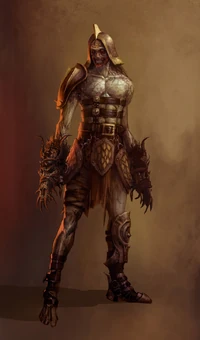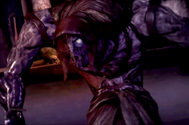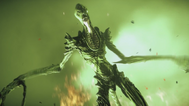Smackdagger (talk | contribs) m (→Trivia) Tag: Visual edit |
(The last paragraph of the intro was missing the word 'a' before 'demon' when saying 'a demon is simply a spirit whose purpose have been perverted'. It's a grammatical fix.) Tag: Visual edit |
||
| Line 18: | Line 18: | ||
Demons often cannot distinguish between a living being and a dead one and will readily take control of either. This is thought to be the cause for the [[Chantry]]'s custom of burning the dead. |
Demons often cannot distinguish between a living being and a dead one and will readily take control of either. This is thought to be the cause for the [[Chantry]]'s custom of burning the dead. |
||
| − | Ultimately, demon is simply a spirit whose purpose has been perverted. Pulling a spirit unwillingly into the mortal world, particularly to achieve a goal out of keeping with its nature, will change a spirit into a demon (however, a spirit passing willingly through the [[Veil]] will not be changed<ref>According to [[Cole]], such spirits become "more themselves."</ref>). Furthermore, an individual anticipating seeing a demon will do so, even if the entity is in fact a spirit.<ref>According to dialogue with [[Solas]], and the events of [[All New, Faded for Her]].</ref> |
+ | Ultimately, a demon is simply a spirit whose purpose has been perverted. Pulling a spirit unwillingly into the mortal world, particularly to achieve a goal out of keeping with its nature, will change a spirit into a demon (however, a spirit passing willingly through the [[Veil]] will not be changed<ref>According to [[Cole]], such spirits become "more themselves."</ref>). Furthermore, an individual anticipating seeing a demon will do so, even if the entity is in fact a spirit.<ref>According to dialogue with [[Solas]], and the events of [[All New, Faded for Her]].</ref> |
== Demonic possession == |
== Demonic possession == |
||
Revision as of 22:39, 27 January 2015
A demon is an oft-malicious spirit from the Fade that embodies a sin and feeds on the darker parts of the mortal psyche like rage, hunger, and desire. According to Solas, a spirit becomes a demon when denied its original purpose. They can be corrupted by being forced to do something so opposed to its purer nature or if they reflect the darker parts of the mortal psyche while they mine a Fade visitor's mind for their thoughts and memories. The more complex the emotions, the more intelligent and powerful the demon who feeds on it.
Demons are categorized into a hierarchy by human observers. Rage is the simplest emotion to feed from so rage demons are often much lower on the power scale. Sloth demons are above rage demons, and are known as masters of disguise. Desire demons are higher still, and have the power to manipulate people without their ever knowing. Most powerful of all are pride demons. They are fearsome creatures, known for their intelligence. However, demons do not abide by this hierarchy. A rage demon can focus on retribution, which is more powerful and complex motivation than simple anger, while a desire demon focused on lust will be less powerful than one who focuses on desire for something more complex.[1]
Dragon Age: Inquisition introduces "envy" , "terror", "despair" and "fear" demons. A terror demon would be subservient to a demon of fear.[2]
Demons do not have genders. Within the Fade, they are able to shapeshift and take the form of their choosing. As creatures from an alternate and malleable reality, a demon’s natural mindset can appear insane to a mortal.
Demons often cannot distinguish between a living being and a dead one and will readily take control of either. This is thought to be the cause for the Chantry's custom of burning the dead.
Ultimately, a demon is simply a spirit whose purpose has been perverted. Pulling a spirit unwillingly into the mortal world, particularly to achieve a goal out of keeping with its nature, will change a spirit into a demon (however, a spirit passing willingly through the Veil will not be changed[3]). Furthermore, an individual anticipating seeing a demon will do so, even if the entity is in fact a spirit.[4]
Demonic possession

Devouring Corpse
As with most spirits, it is essentially impossible for demons to survive in the mortal world without possessing a host. The only known way to exorcise a demon without killing its host is to enter the Fade and confront it directly - but this still entails substantial risks. If the host is killed, the demon returns to the Fade unscathed. Mages, due to their enhanced influence across the Veil, are in the most danger of being possessed.
Abominations are the horrifying result of a demon possessing a mage. However, demons do not only possess the living. When a pride demon takes control of the corpse of a mage, an arcane horror is born, possessing all the spellcasting abilities of a living mage, as well as possessing the ability to heal and even command other animated corpses. Another powerful possessed corpse is a revenant, these are usually possessed by a demon of pride or of desire.
For weaker demons corpses make tempting targets, as the demon cannot sense any resistance. When a sloth demon takes possession of a dead body a shambling corpse is the result. Devouring corpses are held by hunger demons and feed upon the living.
The longer dead also fall prey to possession. A fanged skeleton is a skeleton possessed by a hunger demon. Driven by hunger, these skeletons attempt to consume whatever life they can find and often possess the ability to drain life energy and mana from their victims. Shambling skeletons are possessed by a sloth demon, they are able to use entropic powers against their opponents.
Demons may occasionally possess non-mortal forms to escape the Fade, as well. Trees, for example, may become corrupted. This has the interesting side effect of avoiding the madness usually associated with demonic possession of mortal or sentient beings.[5]
Despite the numerous examples of demonic possession shades prove that demons do not have to possess in order to cross over. They are demons in their true form. In time, such a demon will learn to drain energy from the psyche of those it encounters, just as they did in the Fade. Once it has drained enough, it has the power to manifest. Such creatures do not seek to possess a host and instead exist as a shadow, feeding off the minds of those it encounters.
Notable demons
Pride
Desire
Sloth
Hunger
Rage
Shades
Unknown
Trivia
- According to David Gaider, other types of demons exist, but have yet to be shown - despair, fear, envy and remorse being some of them.[1] He mentioned that at least one new major type of demon will appear in Dragon Age: Inquisition.[6]
- Envy, despair, terror and its more powerful form fear were the demons introduced in Inquisition.
Gallery
See also
![]() Codex entry: Demonic Possession
Codex entry: Demonic Possession
![]() Codex entry: Spirits and Demons
Codex entry: Spirits and Demons
References
- ↑ 1.0 1.1 David Gaider. "Why is Pride the strongest? ". Bioware Social Network.
- ↑ E3 2014 IG Inquisition Demo.
- ↑ According to Cole, such spirits become "more themselves."
- ↑ According to dialogue with Solas, and the events of All New, Faded for Her.
- ↑ Codex entry: Charred Sylvan. See also The Grand Oak.
- ↑ David Gaider. "There should be a Despair Demon". Bioware Social Network.
| ||||||||||||||||||||
| ||||||||||||











